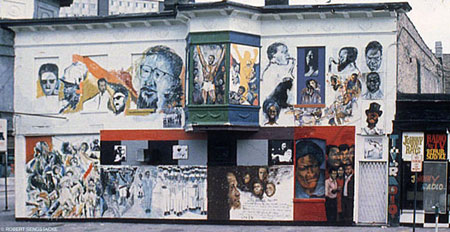I highly recommend the Designing for Change of Chicago Protest Art of the 1960s-‘70s at the Chicago History Museum. Exhibit curators and creators did an excellent job of exploring not just the most familiar and expected stuff of that period, but the diverse—and sometimes almost siloed—movements that grew organically and cross fertilized.
The program for the Chicago Freedom Festival at Soldier Field featured Dr. Martin Luther King and a kickoff for the campaign against slumlords and for housing
desegregation in 1966. The V-in-a-circle device was widely used to promote the campaign and appeared on buttons, flyers, and demonstration signs and banners.
They began with the Chicago Freedom Movement and its campaign against slumlords and for housing desegregation and the creation of iconic v-in-a-circle logo used widely on buttons, posters, and flyers. From there it segues to Respect and Representation for Black Liberation starting with the South Side mural The Wall of Respect and the development of the Black Arts Movement and other cultural manifestations that resounds down to Black Lives Mater artistic representation.
The Wall of Respect mural on the South side was a key touchstone in the emergence of the Black Arts Movement.
In many ways the most
obvious choice is the section on the peace and anti-Vietnam War
(not necessarily the same thing) movements that included material relating to
the Democratic National Convention protests in 1968 and later protests
of the Chicago 7 trial including some ephemera promoting what
would become known as the Days of Rage.
This section includes an important collection of Chicago Seed
covers and related materials.
I was happy to be a resource for the curators on that.
One of several Seed covers featured in the peace and anti-war movement section of the exhibit.
Women’s Liberation in Chicago was
viewed through the lenses not of the “official” middle-class feminist movement
that concentrated on advancement through the system and careerism, but by the pioneering Chicago Women’s
Liberation Union with an explicitly socialist perspective. The CWLU spawned the Women’s
Graphic Collective which specialized in big, bold screen print posters—practically
fine art pieces—that could be obtained at minimal pricing to democratize
both the message and the cultural value.
Part of the Women's Liberation section of the exhibit included Chicago Women's Liberation Graphic Collective posters and the original sign, upper right of Chicago Women's Liberation Union offices.
The LGBTQ+ community had roots in some of the first organizations for homosexuals in the nation and a developing culture that include the arts and journalism that led to the first Gay Pride Parade in honor of the first anniversary of the Stonewall Uprising in New York. Many historians credit that parade, which became an annual Chicago tradition, with the inspiration for Pride Parades nationwide. The particular role of lesbians—who often overlapped into feminist activism—was highlighted by a great selection from Mountain Moving Bus Café which was both a safe refuge and a platform for performance, exhibits, and cultural manifestations, Materials on marching for abortion rights are relevant all over again.
Chicago hosted the first Pride Parade on the first anniversary of the Stonewall Rebellion in New York and inspired annual marches across the country. The unique logo on the lead banner--interlocking gender signs under a power fist borrowed from the Black Liberation movement--was a Chicago contribution the defiant culture.
These groups co-existed and a sometimes seen as part of a broad movement for radical—sometimes revolutionary—change. But they were different in aims and aspirations as well as strategy, and the art culture that developed with them was unique. Male domination and sexism were rampant in some of the otherwise progressive movements and offended radical feminists. The anti-war movement seemed dominated by Whites leaving Blacks often feeling excluded. The rainbow coalition envisioned by the Illinois Black Panthers and the protests of the murder of Chairman Fred Hampton helped to make some connection. Many Blacks were resentful of LGBTQ+ activists for “stealing” their playbook especially regarding a strong cultural bias against homosexuality. Now protests of the wave of murders and disappearances of transgender Women of Color bring communities together.






No comments:
Post a Comment